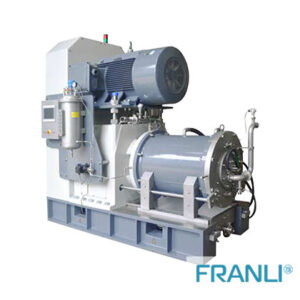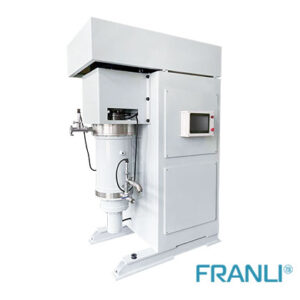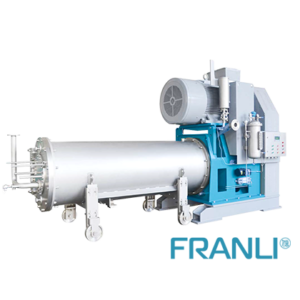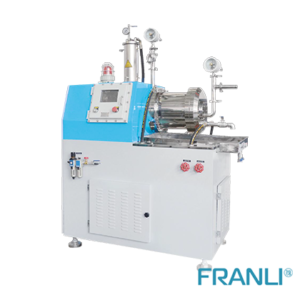What is a laboratory sand mill?
Lab Sand Mill
The laboratory sand mill is widely used in functional ceramics, printing inkjet, TFT LCD color filter dispersion, lithium battery materials, thermal paper, CMP, ceramic ink, nanopowder, nano color paste, food additives, and other nano-grinding fields. It is a kind of grinding equipment compared with the bead mill type used in industrial production.
Application: Paint, Adhesive, Battery, Pharmaceutical industry, Cosmetic
The working principle is the same as that of the sand mill used in industrial production. The materials are passed through a grinding cavity with a rotor, and the grinding cavity is filled with a certain amount of grinding. Medium (grinding beads), is a kind of grinding equipment in which the material collides, kneads, stirs, and mixes with the internal grinding medium through the rotating rotor to achieve the effect of slurry crushing and refining.
Features of laboratory sand mill
- The newly designed centrifugal separation device has a large flow and smooth discharge.
- Grinding media over 0.1mm can be used.
- The arrangement of the rotor and the cylinder is based on the golden ratio.
- Can effectively reduce wear, increase energy utilization, and achieve the best use effect.
- More optimized whole machine design, the overall stability of the equipment is more reliable.
- All imported standard parts such as mechanical seals, bearings, conveying pumps, belts, and pulleys.
The internal and external dual cooling modes can effectively reduce the heat generated during grinding.

The working principle of the laboratory sand mill is the same as that of the ordinary sand mill used in industrial production. Bypassing the material through a grinding cavity with a rotor, the grinding cavity is filled with a certain amount of grinding media (grinding beads), and the material passes through the rotating rotor. A kind of grinding equipment in which the internal grinding media collide, squeeze, stir and mix to achieve the effect of crushing and refining the slurry.
Compared with the sand mill for industrial production, the laboratory sand mill has the characteristics of small size, compact structure, low power, light movement, convenient disassembly and assembly, relatively small output, low noise, and low price. The difference from the sand mill for industrial production is the volume of the grinding chamber. The volume of the laboratory sand mill is as small as 0.1L and as large as 10L and 15L.
The grinding cavity of the experimental sand mill is narrow, the clearance between the levers is small, and the grinding energy is intensive. With the high-performance cooling system and automatic control system, the continuous processing and discharge of materials can be realized, which improves production efficiency. Laboratory sand mills are mainly used to develop new products and obtain accurate test data as a basis for process amplification. Each series of FRANLI sanders has a very good linear amplification effect.
1. Length-diameter ratio: The length-diameter ratio is designed for the cylinder body, and the staggering rod and nail arrangement prolongs the effective time of the material in the mill.
2. Lengthened bearing seat: One-piece processing technology annealing to eliminate welding stress and deep processing by boring machine to solve the problem that the bearing position of the experimental sand mill is not concentric, which causes the spindle to run out, which affects the stability and service life of the equipment.
3. The energy ratio of the experimental sand mill: the new rod-pin type grinding rotor, which concentrates the kinetic energy to give the grinding bead energy ratio. Improve the grinding efficiency and refinement degree, while reducing the resistance of the material in the grinding chamber, it is suitable for materials with medium and high viscosity ultra-fineness requirements.
Welcome to send inquiry to us and let’s make a win win business together !
Guidelines For Sand Mill
The sand mill mainly uses friction, shearing, and collision as effective grinding methods. It is one of the grinding equipment currently applicable to a wide range of material particle sizes and has high grinding efficiency. The energy density per unit volume is large. The control system can complete the continuous grinding and continuous discharging of the slurry, which greatly improves the production efficiency of the sand mill. It has the advantages of high energy density, fine product granularity, small environmental pollution, simple equipment structure, and convenient maintenance.

Sand Mill: Enhancing the Efficiency of Grinding & Dispersion
Sand mills, also known as bead mills or media mills, are mechanical devices used in the field of grinding and dispersion.

Instructions for use of vertical sand mill
The vertical sand mill is a nano-sand mill whose grinding cylinder adopts a suspended structure, raw materials enter from the bottom and discharge from the top.

How to choose the right vertical sand mill & horizontal sand mill?
Vertical sand mills and horizontal sand mills are commonly used equipment for grinding in paint, coating, ink, and other industries. They all rely on the high-speed rotation between the grinding medium and the material for grinding work.

How to deal with the problem of sand mill?
The sand grinding machine, also known as the pearl grinding machine, is used to grind the paint of the pigment with hard wear -resistant beads, glass balls, etc. in a closed cavity.

How to choose a sand mill for paint?
Sand mills are mainly used in industrial fields such as paint coatings, cosmetics, food, daily chemicals, dyes, inks, pharmaceuticals, magnetic recording materials, ferrites, photosensitive films, oxide ceramics, and new energy.

Grinding media for sand mills
Sand mill is a kind of high-efficiency grinding equipment, which is mainly used for grinding materials, and the particle size of the final grinding can reach the nanometer level.
